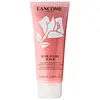What's inside
What's inside
 Key Ingredients
Key Ingredients

 Benefits
Benefits

 Concerns
Concerns

 Ingredients Side-by-side
Ingredients Side-by-side

Glycerin
HumectantPropylene Glycol
HumectantSucrose
HumectantMel
EmollientCI 14700
Cosmetic ColorantCI 17200
Cosmetic ColorantSodium Hyaluronate
HumectantArgania Spinosa Shell Powder
AbrasivePEG-30 Dipolyhydroxystearate
EmulsifyingArginine
MaskingTriethanolamine
BufferingTrideceth-6
EmulsifyingSalicylic Acid
MaskingPanthenol
Skin ConditioningPropanediol
SolventAcrylates/C10-30 Alkyl Acrylate Crosspolymer
Emulsion StabilisingRosa Damascena Flower Water
MaskingCitric Acid
BufferingPrunus Amygdalus Dulcis Oil
Skin ConditioningParfum
MaskingGlycerin, Propylene Glycol, Sucrose, Mel, CI 14700, CI 17200, Sodium Hyaluronate, Argania Spinosa Shell Powder, PEG-30 Dipolyhydroxystearate, Arginine, Triethanolamine, Trideceth-6, Salicylic Acid, Panthenol, Propanediol, Acrylates/C10-30 Alkyl Acrylate Crosspolymer, Rosa Damascena Flower Water, Citric Acid, Prunus Amygdalus Dulcis Oil, Parfum
Water
Skin ConditioningCetyl Ethylhexanoate
EmollientSimmondsia Chinensis Seed Wax
Skin ConditioningGlycerin
Humectant1,2-Hexanediol
Skin ConditioningCetearyl Alcohol
EmollientDicaprylyl Carbonate
EmollientPolyglyceryl-3 Methylglucose Distearate
EmulsifyingCaprae Lac
Skin ConditioningAvena Sativa Kernel Extract
AbrasiveLactic Acid
BufferingLactobacillus/Punica Granatum Fruit Ferment Extract
Skin ConditioningYogurt
Skin ProtectingMelia Azadirachta Flower Extract
Skin ConditioningOcimum Sanctum Leaf Extract
Skin ConditioningMelia Azadirachta Leaf Extract
Skin ConditioningCorallina Officinalis Extract
Skin ConditioningLeuconostoc/Radish Root Ferment Filtrate
AntimicrobialCurcuma Longa Root Extract
MaskingAmmonium Acryloyldimethyltaurate/Vp Copolymer
Palmitic Acid
EmollientGlyceryl Stearate
EmollientStearic Acid
CleansingHydroxyacetophenone
AntioxidantTromethamine
BufferingXanthan Gum
EmulsifyingCaramel
Cosmetic ColorantEthylhexylglycerin
Skin ConditioningSodium Phytate
Myristic Acid
CleansingCitric Acid
BufferingTocopherol
AntioxidantSodium Benzoate
MaskingPotassium Sorbate
PreservativeIron Oxides
Water, Cetyl Ethylhexanoate, Simmondsia Chinensis Seed Wax, Glycerin, 1,2-Hexanediol, Cetearyl Alcohol, Dicaprylyl Carbonate, Polyglyceryl-3 Methylglucose Distearate, Caprae Lac, Avena Sativa Kernel Extract, Lactic Acid, Lactobacillus/Punica Granatum Fruit Ferment Extract, Yogurt, Melia Azadirachta Flower Extract, Ocimum Sanctum Leaf Extract, Melia Azadirachta Leaf Extract, Corallina Officinalis Extract, Leuconostoc/Radish Root Ferment Filtrate, Curcuma Longa Root Extract, Ammonium Acryloyldimethyltaurate/Vp Copolymer, Palmitic Acid, Glyceryl Stearate, Stearic Acid, Hydroxyacetophenone, Tromethamine, Xanthan Gum, Caramel, Ethylhexylglycerin, Sodium Phytate, Myristic Acid, Citric Acid, Tocopherol, Sodium Benzoate, Potassium Sorbate, Iron Oxides
 Reviews
Reviews

Ingredients Explained
These ingredients are found in both products.
Ingredients higher up in an ingredient list are typically present in a larger amount.
Citric Acid is an alpha hydroxy acid (AHA) naturally found in citrus fruits like oranges, lemons, and limes.
Like other AHAs, citric acid can exfoliate skin by breaking down the bonds that hold dead skin cells together. This helps reveal smoother and brighter skin underneath.
However, this exfoliating effect only happens at high concentrations (20%) which can be hard to find in cosmetic products.
Due to this, citric acid is usually included in small amounts as a pH adjuster. This helps keep products slightly more acidic and compatible with skin's natural pH.
In skincare formulas, citric acid can:
While it can provide some skin benefits, research shows lactic acid and glycolic acid are generally more effective and less irritating exfoliants.
Most citric acid used in skincare today is made by fermenting sugars (usually from molasses). This synthetic version is identical to the natural citrus form but easier to stabilize and use in formulations.
Read more about some other popular AHA's here:
Learn more about Citric AcidGlycerin is already naturally found in your skin. It helps moisturize and protect your skin.
A study from 2016 found glycerin to be more effective as a humectant than AHAs and hyaluronic acid.
As a humectant, it helps the skin stay hydrated by pulling moisture to your skin. The low molecular weight of glycerin allows it to pull moisture into the deeper layers of your skin.
Hydrated skin improves your skin barrier; Your skin barrier helps protect against irritants and bacteria.
Glycerin has also been found to have antimicrobial and antiviral properties. Due to these properties, glycerin is often used in wound and burn treatments.
In cosmetics, glycerin is usually derived from plants such as soybean or palm. However, it can also be sourced from animals, such as tallow or animal fat.
This ingredient is organic, colorless, odorless, and non-toxic.
Glycerin is the name for this ingredient in American English. British English uses Glycerol/Glycerine.
Learn more about Glycerin